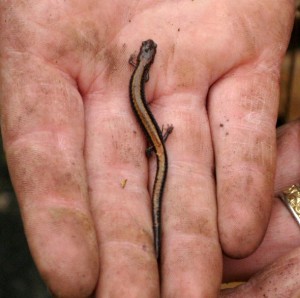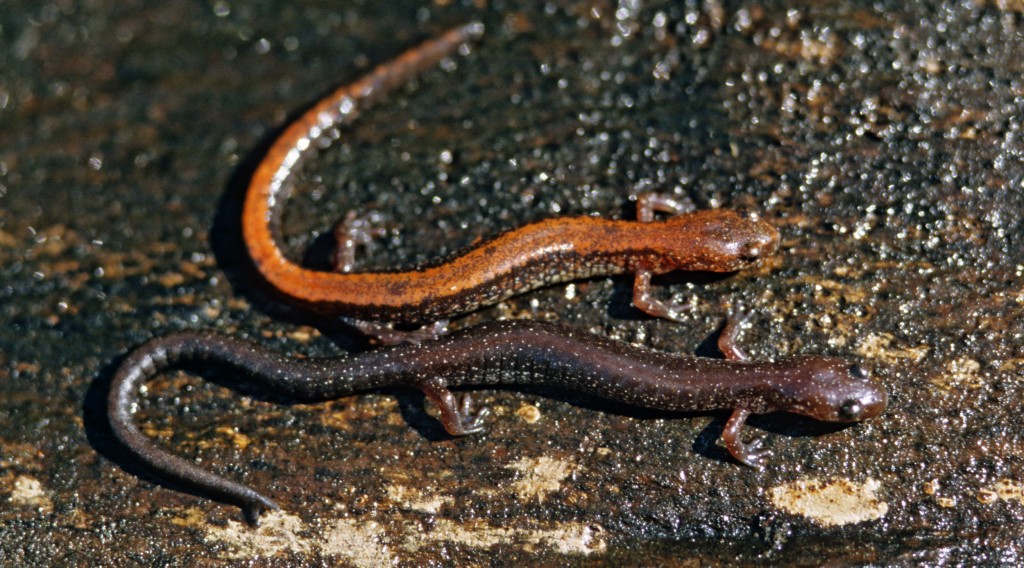The Redback Salamander’s True Colors
Posted in Wildlife on September 11 2013, by NYBG Science
 Not every research program that takes place in the Thain Family Forest is geared explicitly toward the trees, though the work done there does tend to knit together at the end of the day. Think of it as a domino effect; an influence on one organism can herald a drastic fallout for others in the web of an individual biome. And, in some cases, certain varieties of plants or animals are relied on as indicator species—”canaries in the coal mine” that speak to the overall health of a given area, signifying changes for better or worse that might otherwise be too subtle to recognize. Salamanders, wherever they’re found, are often a flagship example.
Not every research program that takes place in the Thain Family Forest is geared explicitly toward the trees, though the work done there does tend to knit together at the end of the day. Think of it as a domino effect; an influence on one organism can herald a drastic fallout for others in the web of an individual biome. And, in some cases, certain varieties of plants or animals are relied on as indicator species—”canaries in the coal mine” that speak to the overall health of a given area, signifying changes for better or worse that might otherwise be too subtle to recognize. Salamanders, wherever they’re found, are often a flagship example.
In recent years, a handful of studies here have focused on the small salamander species that call our Forest home: the northern two-lined salamander (Eurycea bislineata), a water-reliant species native to the U.S. and Canada, and the terrestrial redback or woodland salamander (Plethodon cinereus), a species that has evolved to live away from water. Considering how delicate these quick, slippery little amphibians are on average, it’s quite the feat to strike off and make a living under rocks and leaf litter. Of course, even a particular resilience among their own kind doesn’t excuse them from the effects of climate, urbanization, and other challenges.
Students and scientists in the past have pinged our redback salamanders for studies of urban impact on local populations, as well as the prevalence of skin fungi in the global decline of amphibian species. You can actually check out a short clip on our long term bi-annual salamander counts with Jessica Arcate-Schuler, Director of the Forest, from 2010. But recent studies by Jean-David Moore, a collaborating Forest scientist out of Quebec, have focused on another unique quality of these terrestrial salamanders: their morph.

While the “redback” designation might make the physical appearance of these critters sound obvious, the fact that there is a “lead-backed” morph of the species muddies the waters a bit. And Moore’s ongoing studies hope to uncover just what it is that lies behind the difference in livery. He was kind enough to write us a recap of what his work turned up over the summer:
“I just received the compilation of the salamander monitoring program at The New York Botanical Garden. A total of 829 “woodland” salamanders (Plethodon cinereus) were observed from October 2010 to April 2013, of which 525 were of the red-backed morph and 304 were of the lead-backed morph. These data will be integrated into my database (currently at almost 200,000 specimens compiled, and more than 300 people contacted to date), which will be used to answer this question: Is the lead-backed morph of the salamander Plethodon cinereus really linked to warmer climate?
“In recent decades, studies have suggested that the lead-backed morph is more closely associated with warmer climate than the red-backed morph (Lotter and Scott 1977; Moreno 1989; Gibbs and Karraker 2006; Anthony et al. 2008), promoting this species as a good indicator of climate change. However, I recently found high prevalence of the lead-backed morph much further north than previously reported, up to the northern limit of the species range (in Quebec), where far colder temperatures occurred as compared to studies realised further south. This finding suggests that the lead-backed morph is not so sensitive to cold temperatures.”
As part of his study, Moore is actively compiling data from U.S. and Canadian sources to flesh out our understanding of this fascinating phenomenon in the salamander world, so if you’re involved in similar studies and want to reach out, feel free to leave a note in the comments—we’ll put you in touch! In the meantime, we’ll be keeping tabs on our local redback salamander populations, because they’re not only adorable, but important to the health of our local Forest.
Header image first published here.
Red-back/lead-back morph image courtesy of Jean-David Moore.

